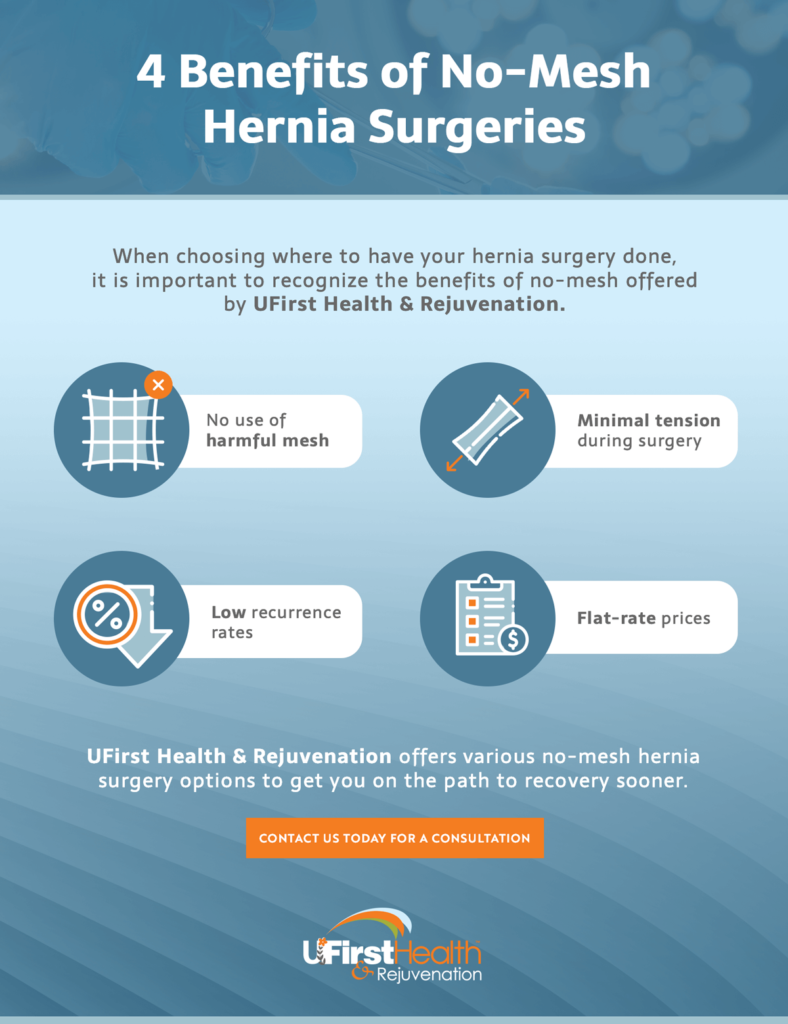No-Mesh Umbilical Hernia Repair in Fort Myers, FL
Umbilical or Belly Button Hernias Repaired with No Mesh
No-Mesh Hernia Surgery in Florida
888-884-0019
If you struggle with an umbilical or belly button hernia, our Florida-based practice could give you your best chance at successful hernia treatment. U First Health & Rejuvenation, also known as Desarda Hernia Center of the United States®, is the only place in the U.S. where you can receive the best-kept secret in umbilical hernia surgery — the “Tomas Technique”.
Since 2009, our hernia specialists, Dr. Robert Tomas, have performed more than 2,000 umbilical hernia repairs without mesh. Learn how no-mesh navel hernia repair is an excellent alternative to standard hernia surgeries.
What Are Umbilical Hernias?
Umbilical hernias happen near your navel or belly button. There is a naturally occurring weakness in this area’s abdominal muscles at the site of the umbilical cord. Umbilical hernias mostly occur in infants just after birth and are typically harmless, usually resolving by age 3 or 4.
However, the area of abdominal weakness can continue throughout childhood and into adulthood, putting women, men and children at risk of an umbilical hernia. Large umbilical hernias usually require surgery to repair as they may worsen with time.
Schedule Your Appointment to Learn About No-Mesh Umbilical Hernia Surgery in Florida
A trip to our Florida-based practice can save you from the pain associated with mesh-related complications. If you suffer from an umbilical hernia, contact us online or call us at 888-884-0019 for a free consultation. We offer an incredible discount if you schedule your initial appointment online. Don’t go anywhere else, because we are the only certified center in the United States endorsed by Dr. Mohan Desarda.
Causes of Umbilical Hernias
During gestation, both the male and female umbilical cord passes through a small opening in a baby’s abdominal muscles. Although this usually closes after birth, sometimes the muscles don’t fully join together and can lead to a belly button hernia.
In adults, too much pressure can contribute to umbilical hernias. This added pressure could stem from:
- Weight gain.
- Excessive coughing.
- Pregnancy.
- Unrelated conditions impacting the abdomen.
Symptoms of Umbilical Hernias
The symptoms of male and female belly button hernias include:
- Swelling or bulge near the belly button area, especially when straining to lift something or use the bathroom.
- Abdominal pain or tenderness.
What Is Umbilical Hernia Repair?
An umbilical hernia repair surgery typically involves your surgeon making a small incision at the base of the belly button and pushing the fatty tissue or bulge back into its proper place. Traditional hernia repair uses surgical mesh to strengthen the weakened spot in the abdominal wall as well as sutures. However, mesh is a foreign body with a long history of defects. This puts patients at high risk of hernia recurrence and other complications.
The “Tomas Technique” method allows Dr. Tomas to repair your umbilical hernia without mesh and its associated risks.
What Is the Tomas Technique for Umbilical Hernia Repair Without Mesh?
The “Tomas technique” uses a three-layer closure to create a strong alternative to surgical mesh. This more natural umbilical hernia repair technique closes the hole in the abdominal wall, allowing the tissue above and below this weakened area to be strengthened. Dr. Tomas uses the “TomasPatent” technique, which includes several rows of non-absorbable sutures to strengthen the umbilical defect as well as the native tissue above and below the defect. Please click on “Tomas Technique” to see our newly obtained patent.
In rare cases, much larger, cantaloupe-sized hernias may require a biological mesh under the weakened abdominal wall. However, over 90% of the umbilical hernia repairs we perform at our Florida practice are completely free of mesh.
What Are the Benefits of No-Mesh Umbilical Hernia Repair Over Other Techniques?
The Tomas patented hernia repair offers the following benefits as an alternative to hernia mesh surgery:
- Rare use of mesh: Plastic surgical mesh can have unpredictable side effects, including pain, infection, rejection, migration and hernia recurrence. In rare cases, we opt for a biological mesh called AlloDerm® that your body will not react to and has an extremely low risk of infection. This biologic mesh is only used in very large hernias where the recurrence may be higher because the fascial tissue is weakened.
- Moderate tension: While there are other mesh-free umbilical hernia repair surgeries, the non-absorbable sutures used can bring together the rectus muscles and strengthen the midline where the defect has developed. The “Tomas Technique” uses non-absorbable sutures to strengthen the native tissue above and below the defect which lowers your recurrence rate as well.
- Low recurrence rate: The “Tomas Technique” dramatically lowers the risk of recurrence. Out of 2,000 umbilical surgeries performed at the Desarda Hernia Center of the United States®, less than 5% of our patients have experienced a recurrence.
- Flat fee: Instead of worrying whether your insurance will cover your no-mesh umbilical hernia repair, we offer flat-rate pricing.
How Does It Work?
The Tomas procedure uses your own tissue by bringing together the rectus muscles to strengthen the midline. When you have an umbilical hernia, the intestine pushes through the abdominal muscles that are supposed to cover it. Most belly button hernia operations use surgical mesh and sutures to cover this hole and strengthen the weakened abdominal wall.
During a Triple layered Tomas repair, Dr. Tomas uses your abdominal muscles and sutures to cover and strengthen the defect, adding dynamic protection for the exposed organ.
Who We Are
U First Health & Rejuvenation is also the Desarda Hernia Center of the United States®. Our Florida practice is the only location in the U.S. performing the no-mesh Desarda hernia repair technique. We have served thousands of patients from different states and countries worldwide, delivering incredible outcomes with few risks of postoperative complications.
About Dr. Robert Tomas
Robert E Tomas, D.O., FACOS, is Board Certified in General Surgery. He performs no mesh inguinal and umbilical hernia surgery using the Desarda Technique for inguinal hernia repairs and his patented no mesh technique for umbilical/ventral hernia repairs. He was recently sponsored by Dr. Mohan Desarda as the Desarda Hernia Center of the United States®. Dr. Tomas has mastered the Desarda technique for inguinal hernia repairs and has performed over 4000 no mesh inguinal hernia surgeries since 2009. Many of his videos can be seen online on YouTube and have been reviewed by Dr. Desarda himself for the accuracy of the technique. Our hernia center receives patients from all over the world for repairs of their inguinal hernias using the Desarda No Mesh Tension Free Repair. Dr. Tomas also performs abdominal cosmetic surgery in Fort Myers, Florida.
Our board-certified hernia repair specialists, Robert E. Tomas, D.O., FACOS has been recognized by Dr. Mohan Desarda as the only providers of the Desarda method in the country,
Dr. Tomas has over 10 years of experience performing belly button hernia repairs in Florida. He also has more than two decades of general surgery expertise. Dr. Tomas is proud to bring relief and exceptional care to patients from all over Florida, the United States and abroad.
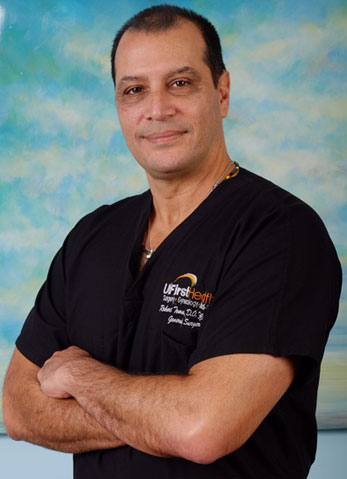
What Is the Process of Getting Belly Button Hernia Surgery?
The team at U First Health & Rejuvenation walks you through the umbilical hernia repair process — before, during and after.
During your free consultation with Dr. Tomas, he will discuss whether you’re a good candidate for this surgical technique. Our team can also walk you through the cost and help you find accommodations in Fort Myers if you are coming from out of town.
Dr. Tomas performs the actual procedure under local with intravenous sedation or general anesthesia, depending on your health profile and individual preferences. A few days after your umbilical hernia repair, Dr. Robert Tomas will check the incision site and monitor your progress. Out-of-town patients are welcome to return home following this checkup. You should be able to go back to a desk job in a week after your procedure.
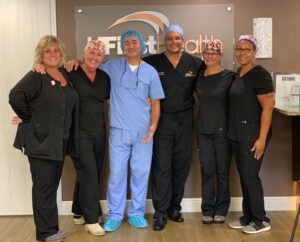
We are the best kept secret in hernia surgery. Make your reservation now and get a special internet rate.
Scroll Down to See Umbilical Hernia Repair Before and After Case Studies
Warning: Graphic Content
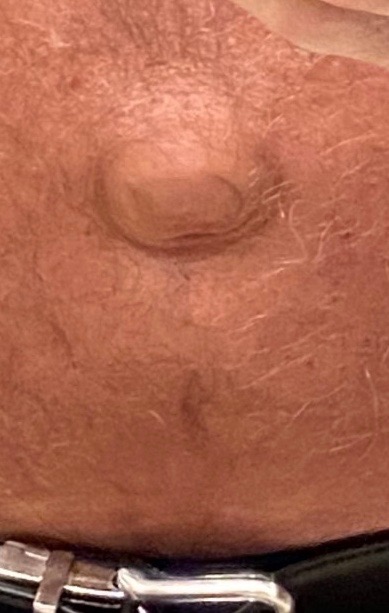
Umbilical Hernia Before
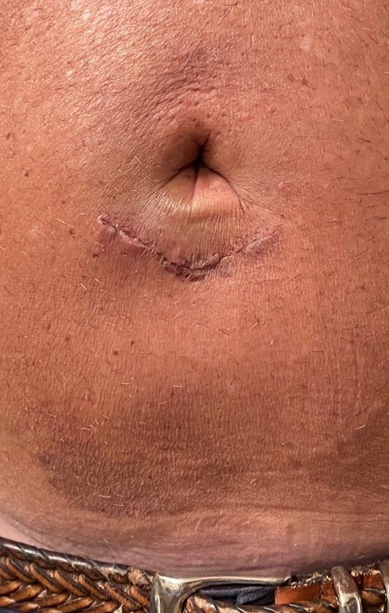
Umbilicus After Repair
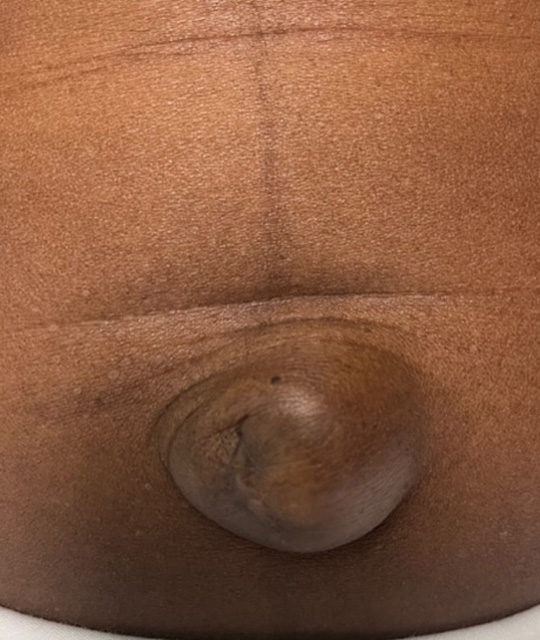
Umbilical Hernia Before

Umbilicus After Repair
Incision (Cut) Made within the naval
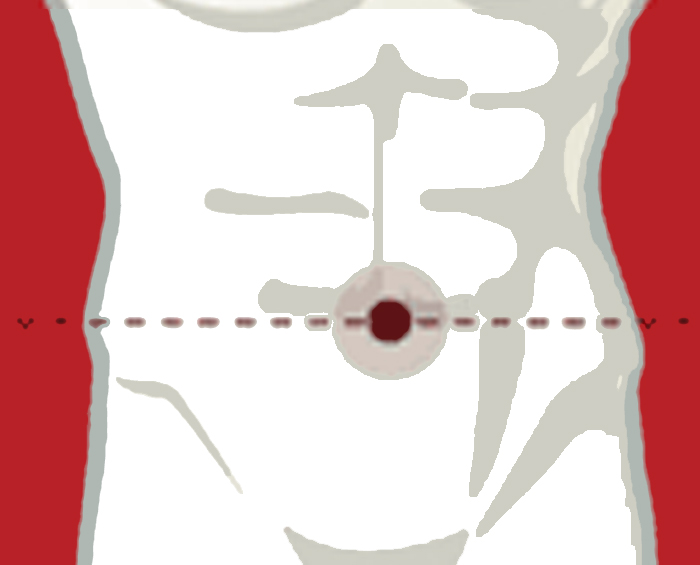
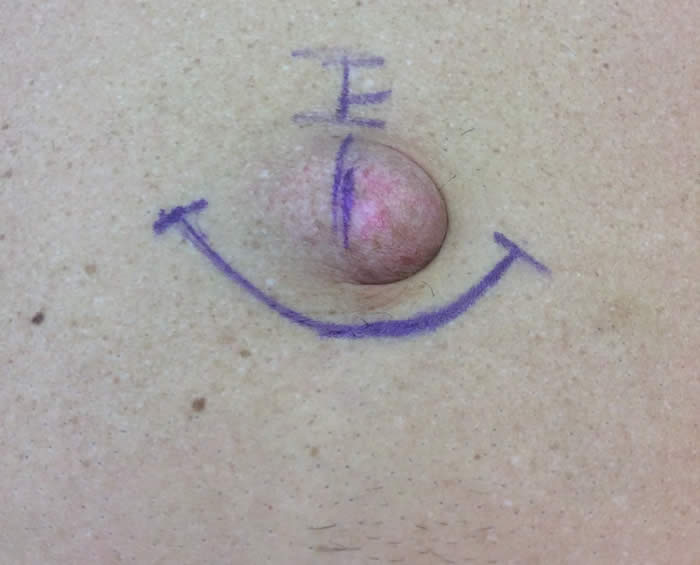
Umbilical hernia with markings of incision for repair.
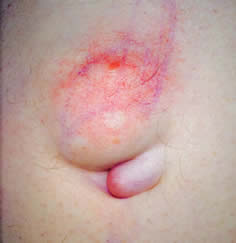
Ventral Hernia Before
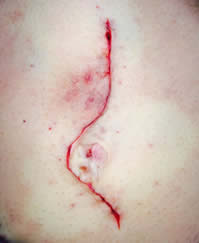
Ventral Hernia After Repair
3. Harrell AG, Novitsky YW, Cristiano JA, et al. Prospective histologic evaluation of intra-abdominal prosthetics four months after implantation in a rabbit model. Surg Endosc. 2007;21:1170-1174.
